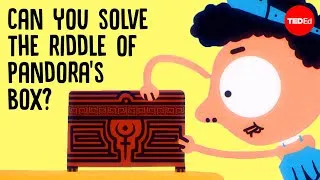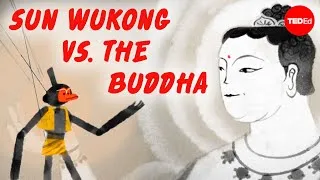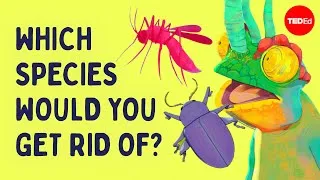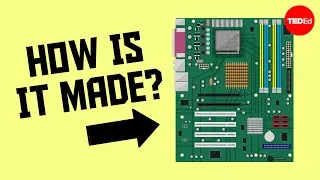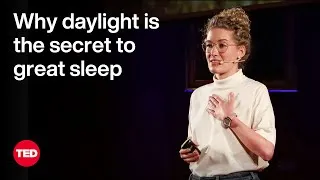請雙擊下方英文字幕播放視頻。
譯者: Helen Chang
審譯者: S Sung
00:06
To human eyes, the world at night
is a formless canvas of grey.
0
6979
4580
人眼看見的夜間世界
是個隱約的灰色帆布。
00:11
Many nocturnal animals, on the other hand,
1
11559
2754
另一方面,許多夜行動物體驗
00:14
experience a rich and varied world
bursting with details, shapes, and colors.
2
14313
5286
有著豐富細節、形狀、顏色,
多姿多彩的世界。
00:19
What is it, then, that separates moths
from men?
3
19599
3891
人與飛蛾的差異是什麼呢?
00:23
Moths and many other nocturnal animals
see at night
4
23490
2908
飛蛾和其他許多夜行動物
夜裡能看得見,
00:26
because their eyes are adapted
to compensate for the lack of light.
5
26398
3750
是因為牠們的眼睛已經適應,
彌補了光線的不足。
00:30
All eyes, whether nocturnal or not,
6
30148
2761
無論是否是夜行的動物,所有的眼睛
00:32
depend on photoreceptors in the retina
to detect light particles,
7
32909
3848
都靠「視網膜」的「受光體」
來偵測光的粒子,
00:36
known as photons.
8
36757
2181
稱為「光子」。
00:38
Photoreceptors then report information
about these photons to other cells
9
38938
4031
受光體把光子的資訊
傳給視網膜的其他細胞和大腦。
00:42
in the retina and brain.
10
42969
1900
00:44
The brain sifts through that information
and uses it to build up an image
11
44869
3560
大腦篩選資訊,
用來建立眼睛感知的環境形象。
00:48
of the environment the eye perceives.
12
48429
2262
00:50
The brighter the light is,
the more photons hit the eye.
13
50691
3708
光越亮,就有越多的光子進入眼睛。
00:54
On a sunny day,
14
54399
1330
在陽光明媚的日子,
00:55
upwards of 100 million times
more photons are available to the eye
15
55729
4530
眼睛接收到的光子
是無月陰夜的數億倍。
01:00
than on a cloudy, moonless night.
16
60259
2391
01:02
Photons aren't just less numerous
in darkness,
17
62650
2770
在黑暗中,不只光子的數量少很多,
01:05
but they also hit the eye
in a less reliable way.
18
65420
3470
光子進入眼睛的方式也不可靠。
01:08
This means the information
that photoreceptors collect
19
68890
2949
這意味著受光體接收的資訊
01:11
will vary over time,
20
71839
1611
會隨時間而變化,
01:13
as will the quality of the image.
21
73450
2150
改變圖像的品質。
01:15
In darkness, trying to detect the sparse
scattering of randomly arriving photons
22
75600
5020
在黑暗中,試圖偵測稀疏、
隨機抵達的散射光子
01:20
is too difficult for the eyes
of most daytime animals.
23
80620
3390
對於大部分的白天動物而言,
太困難了。
01:24
But for night creatures,
it's just a matter of adaptation.
24
84010
3831
但對於夜間生物而言,
只是個適應的問題。
01:27
One of these adaptations is size.
25
87841
3550
其中之一的適應機制是眼睛的大小。
01:31
Take the tarsier, whose eyeballs
are each as big as its brain,
26
91391
4589
以眼鏡猴為例,眼球和腦一般大,
01:35
giving it the biggest eyes compared
to head size of all mammals.
27
95980
4010
牠的眼頭比例,
是所有哺乳動物中最大的。
01:39
If humans had the same brain to eye ratio,
our eyes would be the size of grapefruits.
28
99990
5471
如果人類有同樣的腦眼比例,
我們的眼睛將會大如葡萄柚。
01:45
The tarsier's enlarged orbs haven't
evolved to make it cuter, however,
29
105461
3369
眼鏡猴演化的大眼球,
不是為使它變得可愛,
01:48
but to gather as much light as possible.
30
108830
3051
而是要盡可能地多收集光子。
01:51
Bigger eyes can have larger openings,
called pupils,
31
111881
3160
大的眼睛有更大的開口,
也就是「瞳孔」,
01:55
and larger lenses,
32
115041
1520
和更大的鏡頭,
01:56
allowing for more light to be focused
on the receptors.
33
116561
3270
允許更多的光聚焦在受光體上。
01:59
While tarsiers scan the nocturnal scene
with their enormous peepers,
34
119831
4392
眼鏡猴以巨大的眼睛掃描夜景,
02:04
cats use gleaming eyes to do the same.
35
124223
4209
而貓用的是閃閃發亮的眼睛。
02:08
Cats' eyes get their shine from
a structure called the tapetum lucidum
36
128432
3920
貓眼的亮光來自
「脈絡膜毯」這個結構,
02:12
that sits behind the photoreceptors.
37
132352
2439
位於受光體的後方。
02:14
This structure is made from layers
of mirror-like cells containing crystals
38
134791
3942
這結構由層層含有像鏡子模樣、
晶體結構的細胞所組成,
02:18
that send incoming light
bouncing back towards the photoreceptors
39
138733
3603
把射入光反彈給受光體,
02:22
and out of the eye.
40
142336
1726
然後從眼睛出去。
02:24
This results in an eerie glow,
41
144062
1750
如此產生了詭異的亮光,
02:25
and it also gives the photoreceptors
a second chance to detect photons.
42
145812
4530
並給受光體二次偵測光子的機會。
02:30
In fact, this system has inspired the
artificial cats' eyes we use on our roads.
43
150342
5631
事實上,貓眼啟發我們設計出
嵌在馬路上的反光人工貓眼。
02:35
Toads, on the other hand, have adapted
to take it slow.
44
155973
3680
另一方面,蟾蜍適應了慢活。
02:39
They can form an image
45
159653
1723
牠們能看見成形的圖像,
02:41
even when just a single photon
hits each photoreceptor per second.
46
161376
4325
即使其受光體每秒只收到一粒光子。
02:45
They accomplish this with photoreceptors
47
165701
2145
比人慢25倍的受光體
02:47
that are more than 25 times slower
than human ones.
48
167846
3507
02:51
This means toads can collect photons
for up to four seconds,
49
171353
3133
意味著它收集光子的間隔長達4秒,
02:54
allowing them to gather many more
than our eyes do
50
174486
2876
使得眼睛能在
每個間隔4秒的視覺時間裡
02:57
at each visual time interval.
51
177362
2381
比人收集更多的光子。
02:59
The downside is that this causes toads
to react very slowly
52
179743
4019
缺點是使得蟾蜍反應遲緩,
03:03
because they're only receiving
an updated image every four seconds.
53
183762
4272
因為每四秒才更新一次圖像。
03:08
Fortunately, they're accustomed
to targeting sluggish prey.
54
188034
3440
還好牠們習慣獵食動作緩慢的獵物。
03:11
Meanwhile, the night is also buzzing
with insects,
55
191474
3319
同時,夜間嗡嗡飛著的昆蟲,
03:14
such as hawk moths,
56
194793
1999
如鷹蛾,
03:16
which can see their favorite flowers
in color, even on a starlit night.
57
196792
4462
能看到喜愛的花朵色彩,
即使在只有星光照明的夜空。
03:21
They achieve this by a surprising move -
58
201254
2129
牠們通過異乎尋常的演化:
03:23
getting rid of details
in their visual perception.
59
203383
2830
省略細節的受光體。
03:26
Information from neighboring
photoreceptors is grouped in their brains,
60
206213
3541
鄰近的受光體所接收的信息
在腦裡組合成群,
03:29
so the photon catch of each group
is higher
61
209754
2490
因此每個群組捕獲的光子
較個別受光體的更多。
03:32
compared to individual receptors.
62
212244
2501
03:34
However, grouping photoreceptors
loses details in the image,
63
214745
3677
然而,群組的受光體
損失了圖像的細節,
03:38
as fine details require a fine grid
of photoreceptors,
64
218422
3592
因為更多的細節
需要更細密的受光體網絡,
03:42
each detecting photons from one
small point in space.
65
222014
3770
網絡的每一點都要有受光體。
03:45
The trick is to balance the need
for photons with the loss of detail
66
225784
3790
關鍵是要平衡細節與光子數目
03:49
to still find their flowers.
67
229574
1669
讓牠仍能找到花朵。
03:51
Whether eyes are slow, enormous,
shiny, or coarse,
68
231243
2951
無論眼睛是緩慢的、巨大的、
有光的,或粗略看的,
03:54
it's the combination
of these biological adaptations
69
234194
3051
這些生物適應的組合
03:57
that gives nocturnal animals their unique
visual powers.
70
237245
3711
給予夜行動物獨特的視覺能力。
04:00
Imagine what it might be like to witness
through their eyes
71
240956
2951
想像透過牠們的眼睛看到
04:03
the world that wakes up
when the Sun goes down.
72
243907
2769
太陽下山後的甦醒世界,是何模樣。
New videos
關於本網站
本網站將向您介紹對學習英語有用的 YouTube 視頻。 您將看到來自世界各地的一流教師教授的英語課程。 雙擊每個視頻頁面上顯示的英文字幕,從那裡播放視頻。 字幕與視頻播放同步滾動。 如果您有任何意見或要求,請使用此聯繫表與我們聯繫。


